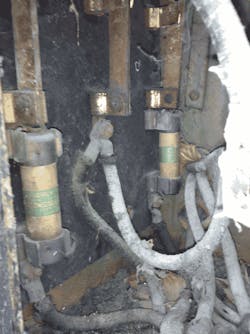How well do you know the Code? Think you can spot violations the original installer either ignored or couldn't identify? Here's your chance to moonlight as an electrical inspector and second-guess someone else's work from the safety of your living room or office. It's your turn to identify the violation. Note: Submitted comments must include specific references from the 2011 NEC.
Hint: Old and confused
Find the Answer
Donald L. Friedland, president of DLF Electric, Inc. in Willoughby, Ohio, asks the question, "How often do you see fusible live front knife switches and splices in something resembling a milk chute?". He adds, "This was found in a 4,000+ sq ft home valued at almost $1,000,000!"
Friedland provided these additional details for us to review.
- Junction box might have originally been used to house an "A" type meter.
- The feeder enters through the concrete floor in the basement into a fusible 100A disconnect.
- The load side wires (No. 6 TW) proceed up though the J box.
- Conduit to meter contains both line and load conductors (no ground).
- Load conductors return to J box and feed exposed knife switches (60A).
- Feeders to sub panels (see splices) are both before and after the meter.
Most of what we see here would never meet present Code rules. In fact, there's a good chance this installation was never even inspected by the AHJ.
Many sections throughout Articles 110, 230, 240, and 250 could be cited here. We could call attention to those that appear to be violated, but let's just keep it simple and agree that this work was performed by a non-qualified person.
As noted in Art. 100, a qualified person is "one who has skills and knowledge related to the construction and operation of the electrical equipment and installations and has received safety training to recognize and avoid the hazards involved." An Informational Note following this definition states, "Refer to NFPA 70E-2009, Standard for Electrical Safety in the Workplace, for electrical safety training requirements."
> Try Another Quiz
About the Author
Joe Tedesco
Tedesco served the industry in many roles during his career. He was a director, senior electrical code instructor for National Technology Transfer, Inc. and American Trainco, Inc.. He was also a codes, standards and seminar specialist for the International Association of Electrical Inspectors and an electrical field service specialist for the National Fire Protection Association in Quincy, Mass. He ran his own business as an NEC consultant and is a Massachusetts licensed master electrician and journeyman electrician and certified electrical inspector (one and two family 2A; General 2B, and Plan Review, 2C). Tedesco also wrote articles for CEE News and EC&M (Code Violations Illustrated and What's Wrong Here?) for more than 15 years and helped launched the Moving Violations video series.
